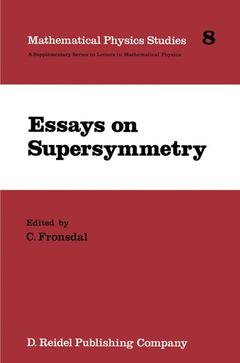Description
Essays on Supersymmetry, Softcover reprint of the original 1st ed. 1986
Coll. Mathematical Physics Studies, Vol. 8
Coordinators: Fronsdal C., Flato M., Hirai T.
Language: French
Keywords
Algebra; dynamics; field theory; gravity; operator; wave equation
Publication date: 10-2011
280 p. · 15.5x23.5 cm · Paperback
280 p. · 15.5x23.5 cm · Paperback
Description
/li>Contents
/li>
to our own also needs to be understood. Such unification may also require that the supersymmetry group possess irreducible representations with infinite reductiori on the Poincare subgroup, to accommodate an infinite set of particles. Such possibilities were 5 envisaged long ago and have recently reappeared in Kaluza-Klein . 6 d' . th 7 S . l' th supergraVlty an m superstnng eory. upersymmetry Imp Ies at forces that are mediated by bose exchange must be complemented by forces that are due to the exchange of fermions. The masslessness of neutrinos is suggestive-we continue to favor the idea that neutrinos are fundamental to weak interactions, that they will finally play a more central role than the bit part assigned to them in Weinberg-Salam theory. There seems to be little room for doubting that supersymmetry is badly broken-so where should one be looking for the first tangible manifestations of it? It is remarkable that the successes that can be legitimately claimed for supersymmetry are all in the domain of massless particles and fields. Supergravity is not renormalizable, but it is an improvement (in this respect) over ordinary quantum gravity. Finite super Yang-Mills theories are not yet established, but there is now a strong concensus that they soon will be. In both cases massless fields are involved in an essential way.
1. Why supersymmetry?.- 2. Why in de Sitter space?.- 3. Why group theory?.- 4. Background.- 5. This book, summary.- 6. Future directions.- Unitary Representations of Supergroups.- 0. Introduction..- 1. General structural problems.- 2. Invariant Hermitean forms.- 3. An example: osp(2n/l).- 3+2 De Sitter Superfields.- 0. Introduction.- 1. Superfields and induced representations.- 2. Induction from an irreducible representation.- 3. Invariant operators.- 4. Massive superfields, “scalar” multiplet.- 5. The “vector” multiplet.- 6. The simplest superfield for N = 2 supersymmetry.- 7. Induction from an irreducible representation.- 8. Wave equations for N = 2.- 9. The spinor superfield and de Sitter chirality.- Appendices.- Al. Linear action for osp(2n/l).- A2. Linear action for osp(2n/2).- A3. Intertwining operators.- A4. Invariant fields.- Spontaneously Generated Field Theories, Zero-Center Modules, Colored Singletons and the Virtues of N = 6 Supergravity.- 0. Introduction.- 1. De Sitter electrodynamics.- 2. Conformal electrodynamics.- 3. De Sitter super electrodynamics.- 4. Extended de Sitter super electrodynamics.- 5. Super conformal electrodynamics.- 6. Extended super conformal electrodynamics.- Massless Particles, Orthosymplectic Symmetry and Another Type of Kaluza-Klein Theory.- 0. Introduction.- I. Geometric preliminaries.- II. Superfield preliminaries.- III. Algebraic representation theory.- IV. Homogeneous space and line bundle.- V. Physical interpretation.- VI. Scalar field on space time.- VII. osp(8) field theory--a beginning.
© 2024 LAVOISIER S.A.S.
These books may interest you

Neutrino 13.25 €



